Andromeda is a large constellation in the northern sky, whose brightest stars complete the quadrilateral of Pegasus. It is easy to find in the sky because its brightest stars lie roughly on a straight line formed by the stars Alpheratz, Mirach, and Alamak. The star Algenib could also be part of this line, but it belongs to the constellation Perseus. To locate it, we can also use the fact that it lies south of Cassiopeia and borders closely on Pegasus—the line of 2nd magnitude stars leads from the northeast corner of the Pegasus square. The constellation lies just on the edge of the Milky Way and contains a number of interesting binaries of varying brightness, spacing, and color, as well as several clusters and nebulae. Galaxies of all types are not lost. The most famous, the Great Andromeda Nebula, which moves almost perpendicularly over our heads during early autumn evenings, is visible as a bright, hazy, elongated cloud just a short distance from the star ν Andromedae.
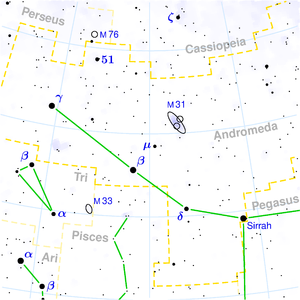
Alamak (γ Adromedae) - The star is located 350 light-years away. To the north of it lies the radiant of the Andromedids meteor shower. One of the most beautiful double stars in the sky. The primary component is orange and has a brightness of 2.3 magnitude, while the companion is greenish-blue and has a brightness of 5.5 magnitude. It is also a close double star (0.5"), but it is not observable with smaller amateur telescopes (in a larger telescope, it appears as a slightly elongated, blurry star). Its orbital period is 61 years. The angular distance between the primary components of Alamak is 9.8 arc seconds, so we can resolve them even with a small telescope with a 5 cm objective diameter.
π Andromedae - A binary star (with stars of 4.4 magnitude and 8.6 magnitude, angular separation of 35.9'') can be resolved with a small telescope with a 6 cm objective diameter. The primary component has an absolute magnitude of -1.1, is 170 times more luminous than the Sun, and is located at a distance of 600 light-years. In a telescope with a 200mm objective diameter, it appears as a bright white star with a faint bluish companion. A faint star of magnitude 13 is also projected in the vicinity.
36 Andromedae - A tight binary star (components 6mag and 6.4mag with a separation of 0.6"-1.4" over 165 years), which serves as a test for larger amateur telescopes. It is located 124 light-years away. The primary component is a giant many times brighter than our Sun. The companion, on the other hand, is very similar to the Sun. It has the same spectral type and the same color - a beautiful yellow.
R Andromedae - The long-period variable star of Mira Ceti type, the brightest in this constellation. It is located near the small triangle of stars θ, σ, and ρ And. At its maximum brightness of 5.8 mag, it is on the edge of visibility to the naked eye, but over 409.33 days its brightness decreases to 14.9 mag (thus changing by 9 magnitudes) and with smaller amateur telescopes it is practically unobservable. The distance is not precisely determined, approximately 790 light-years.
Groombridge 34 (Grb 34) - The red star, a dwarf from the nearby vicinity, is only 11.56 light-years away and visible even with a small telescope at its 8.2 magnitude, about a quarter of a degree away from the star 26 And. A companion of brightness 10.6 magnitude orbits it at a distance of 35.5" in 2,600 years. The pair has a fast proper motion of 2.89" per year. Detailed drawings made at high magnifications once a year reveal this motion relative to the surrounding star field.
M 31
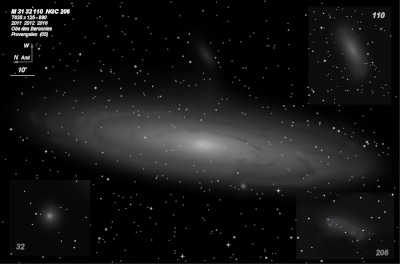
Persian astronomer Abd-al-Rahman Al-Sûfi first mentioned M31 = NGC 224 = h51 in his "Book of Fixed Stars" (964 AD) as the "Little Cloud" lying before the mouth of a Big Fish (an Arabic constellation). Surprisingly, Tycho Brahe didn't mention M31 in his star catalogue (nor Hipparchus or Bayer), which included 6 nebulous objects (only real one was M44). German astronomer Simon Marius made the first telescopic observation of M31 (actually of any nebula) on 15 Dec 1612 and it appeared to be composed of rays of light, increasing in brightness towards the center, mared by a dull, pale light. It appearance "resembling the light of a burning candle, atsome distance, shining through translucent horn." Giovanni Hodierna listed it as a new nebula in his catalog based on his observation in 1654, so apparently he was unaware of Marius' observation in 1612. Cassini, in 1740, represented its shape as nearly triangular. Le Gentil considered it round for some years, then oval, but always of a uniform light. In 1764 Messier wrote "it resembles two cones or pyramides of light, opposed at their bases, the axes of which are in direction NW-SE." Due to these varying descriptions, it was thought the nebula might be variable.
William Herschel first observed M31 in 1780 ("has no star in it") but using a 6-inch on 2 Aug 1783 he noted, "227x, a strong suspicion of stars. This speculum has not light enough. I doubt not but 20 feet will confirm it. 460x, suspicion still stronger." He was obviously mistaken on the resolvability. WH also noted the nebula "begins to shew a faint red colour." Perhaps he detected a slight hue to the nuclear region (red giants), though this seems unlikely. In 1826 John Herschel wrote, "At present it has not, indeed, a star, or any well-defined disk in its center, but the brightness, which increases by a regular gradation from the circumference, suddenly acquires a great accession, so as to off the appearance of a nipple as it were in the midd, of very small diameter (10" or 12")...Its nebulosity is of the most perfectly milky absolutely irresolvable kind, with the slightest tendency to that separation into flocculi above described in the nebula in Orion..."
The quasi-stellar nucleus was observed by Johann Lamont on 13 Oct 1836 with a 10.5-inch refractor at Munich Observatory and measured as 6.9" diameter. George Bond made a remarkable sketch in 1847 using the new 15-inch Harvard refractor, showing two sharply defined dust lanes, a stellar nucleus and M32 and M110 embedded within the halo of M31. He mentioned "a sudden interruption of light, appearing like a narrow, dark band, in which the eye could detect no deviation from perfect straightness, streating, in the direction of the axis of the nebula, entirely across the field of view; exterior to this, with respect to the axis, was another band or canal..." Bond also traced the major axis to a length of 4°. Leopold Trouvelot produced a beautiful sketch of the dust lanes in 1874 at the Harvard College Observatory.
The spiral nature, though, was first revealed in photographs by Isaac Roberts in 1888 with a 20-inch reflector (reproduced in many publications) and E.E. Barnard in 1890 with the 12-inch refractor, though neither used in the word "spiral" in their papers. Roberts speculated wildly on the nature of M31, suggesting it was a "new solar system in the process of condensation from a nebula" and the two companions, M32 and M110, were "already undergoing their transformations into planets."
Ernst Hartwig discovered the first extragalactic supernova on 20 Aug 1885 near the center of M31. SN 1885A = S And reached mag 5.85 and faded to mag 14 a half a year later. The brightness (if a nova) seemed evidence that M31 was relatively nearby (within the Milky Way). In 1899, though, German astronomer Julius Scheiner obtained a spectrum using a 7.5 hour exposure and found "No traces of bright nebular lines are present, so that the interstellar speace in the Andromeda nebula, just as in our stellar system, is not appreciably occupied by gaseous matter." He further stated "previous suspicion that the spiral nebulae are star clusters is now raised to a certainty, the thought suggests itself of comparing ..our stellar system, with especial reference to its great similarity to the Andromeda nebula." This added strong support for the "island-universe" theory. Hubble first identified a Cepheid variable (V1) in M31 on a plate taken October 5-6, 1923. In 1944, while the Los Angeles area was in a World War II blackout, William Baade first resolved the central region of M31, M32, M110 as well as NGC 147 and NGC 185 using the 100-inch at Mount Wilson.
400/500mm - 18" a total of 38 globular clusters have been tracked down in M31 as well as 9 star clusters.
Notes by Steve Gottlieb
NGC 891
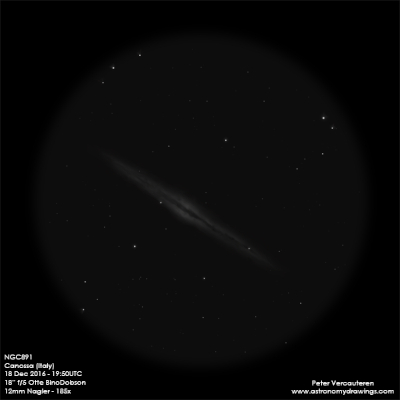
80mm (11/13/07): I was surprised how evident the galaxy appeared at 25x in the 80mm finder.
William Herschel discovered NGC 891 = H V-19 = h218 on 6 Oct 1783 and described "a considerably bright nebula about 15' long and 3' broad; its length is divided in the middle by a black division at least 3' or 4' long." On 17 Oct 1786 (sweep 614), he logged "cB, about 15' long and 2 or 3' broad, bM, nearly in the meridian, a little from sp to nf." On 24 Oct 1786 (sweep 621), he swept it again as "cB, gbM, about 15' l and 3' br, a black division in the middle in the direction of the length; at least 3 or 4' long." In the notes section of his first catalogue, William mentioned that Caroline found this object on 27 Aug 1783 in his first catalogue, but this is a transcription error in the handwritten copy sent to the printer as she found NGC 205 = M110 on that date (sketched earlier by Messier). Admiral William Smyth repeated this error in his Cycle of Celestial Objects (1844). WH also found two members of nearby Abell Galaxy Cluster 347 (NGC 898 and 910) on 17 Oct 1786. He published a sketch in his 1811 paper (Fig. 12) as an illustration of "nebulae that are remarkable for some particularity in figure or brightness."
John Herschel noted on sweep 182 that it "has a chink or dark division in the middle and two stars." He sketched the galaxy and remarked "An extraordinary object. Perhaps the figure is too nicely symmetrical as it certainly is too sharply defined. It is of the last degree of faintness and may very well be though full in the field of view. There can hardly be a doubt a thin flat ring of enormous dimensions seen very obliquely." The galaxy was also sketched at Birr Castle in 1850-51 and Dreyer noted, "I think the split is broader at one end, and that the nebula is a little more sharply defined on the following [Eastern] branch. The central part is longer, but perhaps not so bright as on the preceding branch. A bifurcation suspected at south end by Lord Rosse."
200/250mm - 8" (11/28/81): fairly bright, large, edge-on, central bulge.
300/350mm - 13" (9/11/82): dust lane visible with averted.
400/500mm - 17.5" (8/31/86): bright, extremely large, edge-on 5:1 SSW-NNE, 10'x2'. A striking dust lane bisects the galaxy and is most prominent through the bulging central region.
900/1200mm - 48" (10/25/11): at 375x, the stunning edge-on NGC 891 was one of the top highlights of the observing week with the 48". The galaxy nearly filled the 16' field, stretching nearly 12' by 2' SSW-NNE. A 17th magnitude star is superimposed close to the NNE tip and a mag 16.5 star is near the SSW end. The brighter, bulging central region extends 2.5' with a mag 12 star just north of the core on the west side. A similar star is superimposed on the southern extension along with a few fainter stars. A very high contrast dust lane slices through most of the galaxy except at the tips, where the galaxy fades out. I was surprised how broad the dust lane appeared, particularly through the central section. Although the dust lane perfectly bisects the galaxy into two symmetric halves, the edge of the lane was ragged and uneven.
MAC 0222+4222 = ZOAG G140.39-17.38 was visible just off the east edge, 2.3' NNE of center and collinear with two mag 12 and 13.3 stars off the west edge of the galaxy. It appeared as a very faint, elongated glow, ~15"x6". Once identified I could hold this galaxy nearly continuously with averted vision. In addition, an extremely compact anonymous galaxy is just 50" NW the center of NGC 891 and 40" SE of the mag 13.3 star. It was visible continuously at 375x and 488x as a faint glow, roughly 6" diameter. Surprisingly this object is not listed in NED, HyperLeda or SIMBAD, though it's probably no fainter than mag 16.5.
Notes by Steve Gottlieb
NGC 752
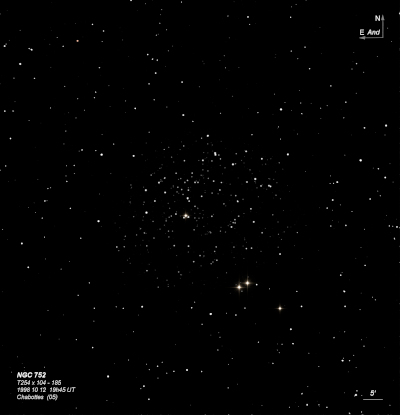
Caroline Herschel discovered NGC 752 = H VII-32 = h174 on 29 Sep 1783, though this cluster is a naked-eye object. According to Wolfgang Steinicke, William found it a month earlier on 24 Aug, while observing with his 6.2-inch reflector. On 21 Sep 1786 (sweep 599), he called it "a vL coarse scattered cluster of vL stars, irregularly round, very rich. I suppose it takes up half a degree." Later he noted "like a nebulous star to the naked eye." But Italian astronomer Giovanni Batista Hodierna may have found the cluster earlier around 1654.
200/250mm - 8" very large, bright, many doubles, overfills low power field. Easy naked-eye open cluster in dark sky.
400/500mm - 17.5" (11/1/97): easy naked-eye cluster, overfills the 100x field (20mm Nagler). The brightest star is a yellowish mag 7 star just south of center. Two equal mag companions to the south form an isosceles triangle. There are no dense regions and the many brighter mag 9-10.5 stars are pretty evenly distributed throughout the field. Many of the stars appear to be arrange in long strings and arcs, though. There are perhaps 150 stars in the field (difficult to count) with a few nice pair and trios. Off the SW side just out of the field is a wide bright pair of mag 5.7/5.9 stars at 3.6' (naked-eye). The western of these two stars (56 Andromedae) has a striking orange-red hue and a faint companion.
Notes by Steve Gottlieb
M 110
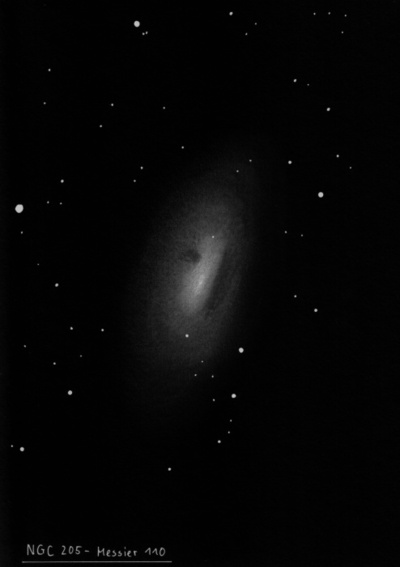
Caroline Herschel discovered M110 = M110 = H V-18 = h44 on 27 Aug 1783. In the 1785 Philosophical Transactions, William wrote "there is a very considerable, broad, pretty faint, small nebula near it; my sister discovered it, August 27th, 1783, with a Newtonian two-feet sweeper." Charles Messier probably made an earlier observation on 10 Aug 1773, though no report was published, nor does it appear in his notes. A sketch published in 1807, though, showed both companions to M31. Kenneth Glynn Jones suggested adding NGC 205 as M110 in a 1967 Sky & Telescope article. William Herschel first observed it on 5 Oct 1784 (sweep 282). On 17 Oct 1786 (sweep 613), he recorded "vB, mE, above 20' long nearly in the meridian; a few degrees from np to sf, the branches lose themselves." On 24 Oct 1786 (sweep 621), he also logged "eB, mE. I suppose not less than 1/2° long and 10 or 12' broad.; vgmbM; so as to come to a luminous nucleus. The time very inaccurate, the telescope being off the roller, and only guided by hand."
M110 was observed with Lord Rosse's 72" on 2 Nov 1850 and "spirality" was suspected (falsely). A later observation on 16 Oct 1855 recorded "vL; mE np by sf; sharp nucleus, for some distance round which, the neb. is bright and then suddenly decreases; there is a bright star np the nucleus; and another involved in sf end; another in preceding border.”
200/250mm - 8" (10/4/80): fairly bright, large, elongated ~N-S, companion to M31.
300/350mm - 13.1" bright, very large, elongated 5:2 NNW-SSE, 10'x4', quite prominent but only a gentle broad concentration. G73, the brightest globular cluster in M110 (or associated with M31), lies 6' E of center and appears as a 15th magnitude "star".
Notes by Steve Gottlieb
M 32
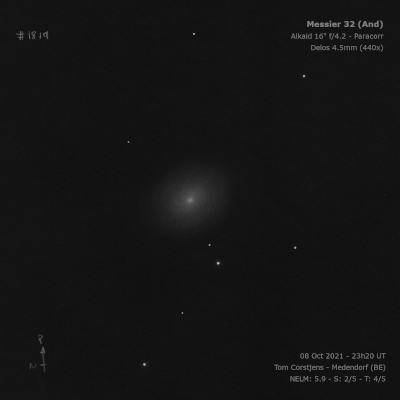
15x50mm (7/26/06): an intense "star-like" core is surrounded by a small halo in my IS binoculars.
Guillaume Le Gentil discovered M32 = NGC 221 = h51 on 29 Oct 1749. He reported "While observing the Andromeda Nebula with a fine 18-foot telescope ... I saw another small nebula, about one minute in diameter which appeared to throw out two small rays; one to the right and the other to the left." Messier found it independently in 1757 while observing M31, unaware of Le Gentil's earlier observation.
In the Appendix to the 1912 'Scientific Papers of Sir William Herschel' this description is given of M32: "1813, December 26, 20 feet telescope, a vB R nebula, vgbM, up to a nucleus." John Herschel recorded (1 Oct 1828), "eB; pL; sbM to a * 10m; 40"; a small star follows it 11.5 seconds."
200/250mm - 8" (8/24/84): very bright, moderately large, round, 24' S of M31.
300/350mm - 13.1" (8/24/84): very bright, moderately large, elongated 4:3 NNW-SSE, about 4'x3', increases to small very bright core which is almost stellar. Located 24' S of the center of M31.
600/800mm - 24" (11/24/14): extremely high surface brightness, large, elongated at least 4:3 NNW-SSE, ~5'x3.5'. The large halo is highly concentrated to a small very bright core. The core itself is sharply concentrated to a very small, very bright nucleus punctuated by an intense stellar nucleus.
Notes by Steve Gottlieb
NGC 7662
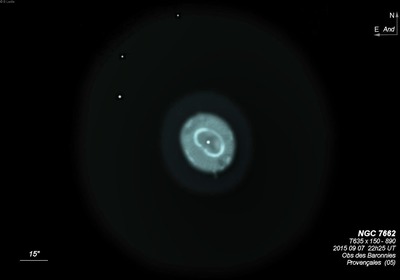
William Herschel discovered NGC 7662 = H IV-18 = h2241 on 6 Oct 1784 (during sweeps 281-285, which was made in the east) and noted "bright, round, a planetary [with a] pretty well defined disk, 15" diameter with a 7 feet reflector." In his 1811 PT paper, he write "A beautifully bright round nebula, have a pretty well defined disk of about 10 or 12" in diameter. It is a little elliptical, and has a very small star following, which gives us the idea of a small satellite accompanying its planet [from 3 Oct 1790, sweep 964]. It is visible in a common finder as a small star." This may be the first time "planetary" is actually used although earlier, Darquier describes M57 "... as large as Jupiter and resembles a fading planet."
On 1 Oct 1828, John Herschel recorded "A fine planetary nebula. Diameter 12"; with 240 beautifully defined, light, rather mottled, and the edge the least in the world unshaped. It is not nebulous, but looks as if had a double outline, or like a star a little out of focus. A perfect circle." JH measured the 13th magnitude star ~50" NE of center several times (interested in it as a possible satellite of the planetary) and noted "These satellites of planetary nebulae out to be especially attended to."
32 observations were made with Lord Rosse's 72". It was first observed by Rosse and Johnstone Stoney on 31 Oct 1848, "Has a central spot, at moments very dark." Lord Rosse and Stoney made sketches on 16 Dec 1848 revealing the double ring structure and brighter arcs (1850 publication, Fig 13, Plate XXXVIII). Bindon Stoney's sketch on 16 Sep 1852 using a freshly polished speculum shows a prominent central star within a spiral shaped nebula and well-defined "arms".
Using a 9.5" refractor in 1855, Father Secchi described (and sketched) a slightly darker horseshoe-shaped central region and a brighter outer arc, a questionable amount of detail for that aperture. Joseph Winlock and George Searle, observing with the HCO 15-inch refractor around 1866, did not report the central star but "Two edges seen...as of a brighter nebula placed over a dimmer one. The brighter and fainter ellipses have major axes slightly differing in direction; the brighter having the position angle of its major axis 10° to 15° the large"
Barnard thought the central star was variable based on observations with the Yerkes 40-inch in 1897 and wrote a paper in 1908 on "The Variability of the Nucleus of the Planetary Nebula NGC 7662" (MNRAS, 68, 465). The paper includes a superb sketch made with the 40-inch refractor at Yerkes. In 1935, John Duncan wrote "The bright ring of NGC 7662, like that of NGC 6720, has a vivid bluish-green color; but the outer shell, seen with a large reflector [probably with the 60"] on a favorable night, has a pronounced reddish hue."
The nickname "Blue Snowball" is from Leland S. Copeland’s description (1960), "looking like light blue snowball.”
200/250mm - 8" (9/25/81) : slightly darker center at 300-400x, irregular surface brightness.
300/350mm - 13" (9/11/82): darker center, faint outer shell.
400/500mm - 17.5" (10/13/01): at 500x, this blue high surface brightness planetary has a beautiful double-shell structure with a small, dark center. The bright inner structure has a delicate, embedded thinner ring of very high surface brightness, though weaker at the following end. In the center of this ring is a small, darker hole. The fainter, outer envelope is elongated SW-NE, ~35"x25", giving an asymmetric appearance with the outline of the inner ring.
17.5" (10/12/85): extremely bright, very high surface brightness, fairly small, easily takes very high power. At 410x, the planetary appears weakly annular with a slightly darker center. There is a second outer shell, which exhibits subtle structure due to an irregular surface structure, blue-green color is evident. Central star not seen.
900/1200mm - 48" (10/24/14): superb view of the double-shell structure at 610x and 813x. The inner shell is elongated ~3:2 SW-NE, ~18"x12", and contains a remarkable, bright thin rim, so it appears like a racetrack with a dark interior. This delicate but high surface brightness ring is brightest along a 90° arc around the northeast end and nearly as bright in a matching 90° arc on the southwest end. The rim is noticeably weaker on the west and east sides. The elongated darker hole spans a large percentage of the inner shell and is punctuated by a faint, but steadily visible central star.
The outer shell is twice the size (~35"x25"), slightly less elongated, and a bit offset in its major axis (SSW-NNE). The outer rim also has two brighter arcs or strips, but only 25°-30° in length. The more prominent arc is on the southeast side with a weaker strip symmetrically placed on the northwest edge. These strips are 90° offset from the much brighter inner arcs. The outer shell appears irregular in surface brightness with an impression of striations. Surrounding the outer shell there appears to be a very low surface brightness outer halo.
Notes by Steve Gottlieb
NGC 7640
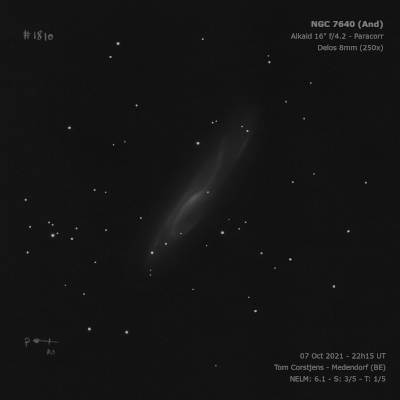
William Herschel discovered NGC 7640 = H II-600 = h2236 on 17 Oct 1786 (sweep 613) and recorded "pB, mE a little np to sf but nearly in the meridian, lbM, resolvable, about 5' long and 1.5' broad." On 1 Oct 1828, JH logged "F; L; mE from a bright to a faint star; vlbM; 2 1/2' l, 20" br. See fig. 60."
200/250mm - 8" (11/8/80): faint, large, very elongated streak N-S. There are stars at both the north and south end.
400/500mm - 17.5" (8/8/91): moderately bright, very large, very elongated 4:1 N-S, 7.0'x1.5'. The large, slightly brighter middle bulges out a little. A mag 13.5 star is at the SE edge of the core 33" from the center. Bracketed by two mag 11 stars at the north end 3.0' NNW of center and just west of the south end 2.6' SSW of center. An extremely faint mag 15 star is embedded near the north end.
600/800mm - 24" (10/4/13): at 200x appeared bright, very large, nearly edge-on 4:1 N-S, ~6.5'x1.5'. Very asymmetric appearance with a brighter, elongated core, 1.0'x0.5', which is oddly angled to the major axis in PA 20° (SSW-NNE). A mag 14 star is just off the SE side of the core. The galaxy dims more noticeably on the south side, but is brighter along the western half (DSS shows this is a long spiral arm). A mag 11 star is just west of the northern end of the galaxy [3.1' NNW of center] and two mag 14.5-15 stars that are collinear with the mag 11 star are superimposed on the north side. The northern half of the galaxy is also asymmetric with a slightly brighter strip (arm) extending N-S and a very low surface brightness (outer arm) near the mag 11 star. Additional mag 11 stars bracket the galaxy just west of the south end and 1.8' NE of center.
Notes by Steve Gottlieb
NGC 404
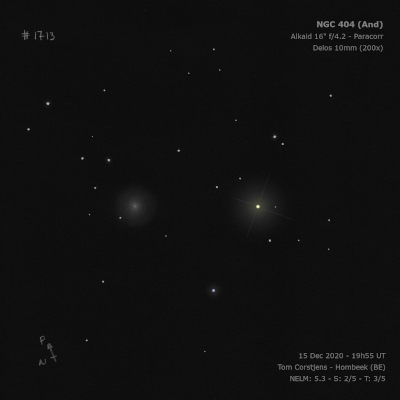
William Herschel discovered NGC 404 = H II-224 = h89 on 13 Sep 1784 (sweep 271) and recorded "pretty bright (not withstanding the light of Beta Andromeda, which is in the field with it), cL, R, bM." The observers on LdR's 72" tried to resolve this nebula. R.J. Mitchell reported on 16 Oct 1855, "pL, B. I have no doubt it is a cluster. The F borders of the nebula extend a long way out, involving several stars."
300/350mm - 13.1" (12/22/84): bright, round, bright stellar nucleus. Located 7' NW of Beta Andromedae (V = 2.1)!
400/500mm - 17.5" (10/13/01): bright, fairly large, round, at least 2' diameter. Contains a bright 30" core that increases steadily to a bright stellar nucleus. Located 7' NW of mag 2.1 Beta Andromedae (Mirach), which detracts somewhat from viewing.
Notes by Steve Gottlieb
NGC 7686
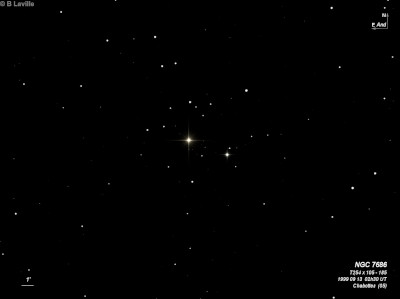
William Herschel discovered NGC 7686 = H VIII-69 = h2249 on 3 Dec 1787 (sweep 787) and recorded "a coarsely scattered cluster of pretty large stars. Contains one 8m in the sf part." On 14 Sep 1829 (sweep 209), JH logged "a bright coarse cluster 7' diam; seen in full moonlight. Place of the chief star = 7m; about a dozen 9...11m, and many 12...14m."
200/250mm - 8" (8/16/82): about three dozen stars resolved including three bright stars mag 6.5/7.5/8.5 and many faint stars over haze, elongated E-W, irregular outline.
400/500mm - 17.5" (7/31/92): about 75 stars in a 15' field surrounding mag 6.3 SAO 53088, elongated E-W. A group of seven faint stars to the west of the mag 6 star is the only fairly rich portion. There is a large region almost devoid of stars to the north and NW of the bright star consisting of two circular blank holes in contact. A string of stars extends out from cluster to the west.
Notes by Steve Gottlieb
NGC 108
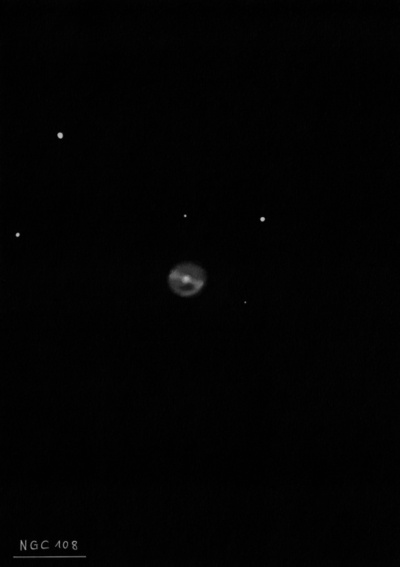
William Herschel discovered NGC 108 = H III-148 = h21 on 11 Sep 1874 (sweep 266) and noted "vF, pL, lbM." JH made two observations, logging it on 16 Sep 1828 as "pB; R; psbM; 20"."
R.J. Mitchell, observing on the 72" on 3 Nov 1855, recorded "E sp nf, the arms being vF, and p one rather the brighter, they are perhaps cut off from central Nucl. by dark spaces, but all this is very uncertain. Night not good."
400/500mm - 17.5" (10/17/87): moderately bright, fairly small, small very bright core, faint extensions SSW-NNE.
Notes by Steve Gottlieb
UGC 95
Probably a physical pair with NGC 27, although there is no sign of interaction on the SDSS image.
600/800mm - 24" (8/25/19): Superthin UGC 95 (ratio 12:1) forms a close pair with much brighter NGC 27, just 1.5' NE. At 225x and 324x it appeared as a moderately large, thin ghostly sliver, ~10:1 N-S, 1.0'x0.1'. Very low nearly even surface brightness with a slightly brighter core. I could often hold it continuously at 225x.
Notes by Steve Gottlieb
NGC 272
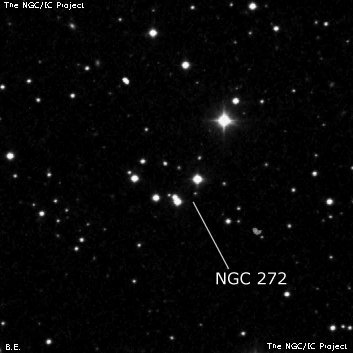
Heinrich d'Arrest discovered NGC 272 on 2 Aug 1864 with the 11" refractor at Copenhagen. His single position points directly to this group of stars. It is listed in the 4th edition of the Gosta Lynga catalogue but was removed from the 5th edition. Visually it appears to be a scattered asterism.
400/500mm - 17.5" (9/26/92): 9 stars in a 5' diameter forming a "hook" asterism. Includes a mag 9 star and a close double star. Appears to be fully resolved and only an unimpressive, scattered asterism.
Notes by Steve Gottlieb
NGC 956
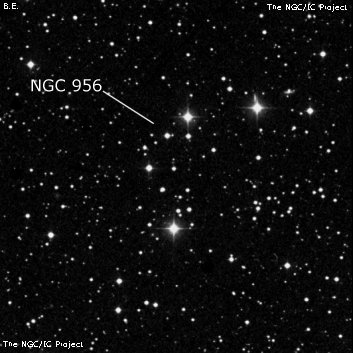
John Herschel discovered NGC 956 = h228 on 23 Dec 1831 and described a "p rich cl; 2 or 3 B and about 20 st 13...15m; a star 9th mag taken" His position is 1' SW of the mag 9.3 star in Herschel's description.
400/500mm - 17.5" (11/26/94): 15 stars mag 12-14 and two mag 9 stars in a 5'x2' group, very elongated N-S. The two mag 9 stars bracket the group at the north (mag 8.9 SAO 38098) and south ends. Not rich but stands out reasonably well at low power as the stars form a rough curving "S" asterism. Two additional mag 9/10 stars are 3' and 5' W of SAO 38098 but do not appear part of the cluster. The classification of this group as a true cluster is doubtful.
Notes by Steve Gottlieb
IC 239
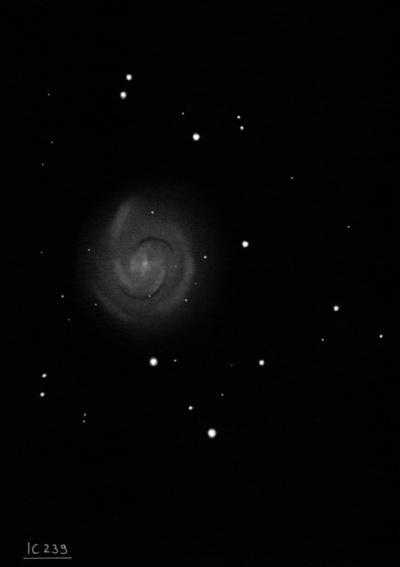
Isaac Roberts discovered IC 239 in 1893 and it was announced in MNRAS 54, 371 (1894), "Photograph of a 'New' Spiral Nebula in Perseus." He noted "the convolutions of the spiral is very faint, but clearly visible on the negative, and involved in them are four 14-15 mag stars and 6 or 7 stars, or star-like condensations, less bright than 16th mag. The convolutions are symmetrical, and proceed from a very faint star-like nucleus."
400/500mm - 17.5" (8/6/02): at 274x appeared faint, fairly large, slightly elongated ~N-S, ~3' diameter. The galaxy exhibited only a broad, weak concentration with no defined core. The halo faded at the edge and was ill defined. Situated between mag 8.6 SAO 55698 just off the south end 2.2' from center and a mag 9.6 star 3.3' N within a distinctive asterism of 5 brighter stars. Located ~45 due west of NGC 1023.
Notes by Steve Gottlieb
NGC 80
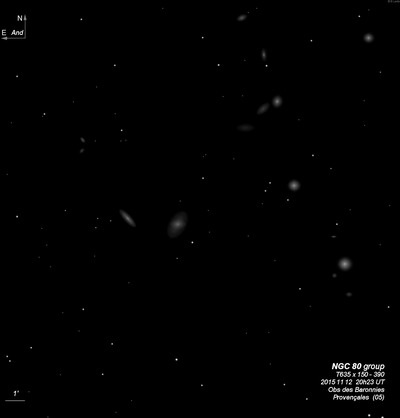
John Herschel discovered NGC 80 = h16 on 17 Aug 1828 and noted "F; S; R; psbM; 15"." The NGC 80 group was observed 5 times with Lord Rosse's 72" and R.J. Mitchell's observation on 19 Sep 1857 reads "S; R; or nearly so; and lbM." The NGC position matches UGC 203 = PGC 1351.
300/350mm - 13.1" (9/29/84): moderately bright, fairly small, almost round, small bright core.
400/500mm - 17.5" (9/19/87): moderately bright, fairly small, sharp concentration, very bright core, stellar nucleus. Brightest in a group with NGC 81, 83, 85, 86, 91, 93, 94, 96, IC 1546 and MCG +04-02-010. Forms a close pair with extremely faint NGC 81 1.6' NNE and NGC 83 is 5.3' NNE.
Notes by Steve Gottlieb
NGC 828
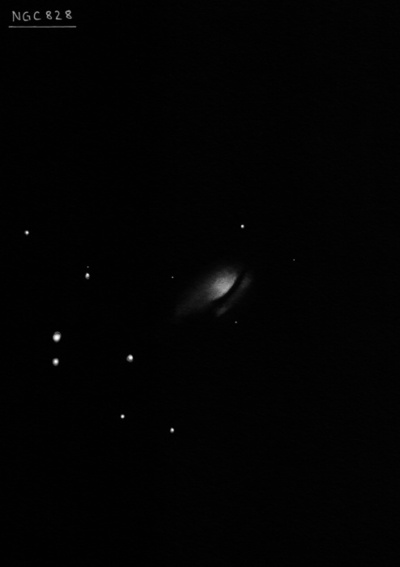
William Herschel discovered NGC 828 = H II-605 = h197 on 18 Oct 1786 (sweep 618) and logged "pB, S, iF." John Herschel logged it in Oct 1828 (sweep 188) "pB; R; gbM; has a D* 15 sec following." This galaxy was observed 6 times at Birr Castle with the first observation on 4 Nov 1848 (possibly by Lord Rosse): "F, scarcely seen in finder, another S neb 60° np 1.5' dist, if it be not a F *." A later observation noted "Either a single R neb with * inv sf center or double." This galaxy is a disrupted spiral with a dust lane on the south side of the core, so some structure was resolved.
400/500mm - 17.5" (11/14/87): moderately bright, fairly small, oval WNW-ESE, bright core. A wide double star with components 10.5/11 (separation 25" in PA 0°) are 3' E. Located 15' NW of the bright double star 59 Andromedae = 6.1/6.8 at 17".
Notes by Steve Gottlieb
NGC 252
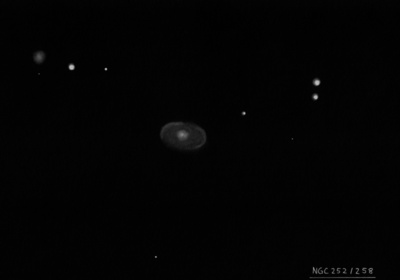
William Herschel discovered NGC 252 = H II-609 = h59 = h60 on 26 Oct 1786 (sweep 626) and logged "pB, S, iR, gbM." John Herschel made 4 observations under h59 and a 5th under h60.
Both Herschels missed NGC 258 and NGC 260, which were found by Lord Rosse's assistant George Johnstone Stoney on 22 Dec 1848 ("3 neb in a line, 2 of the novae").
400/500mm - 17.5" (10/17/87): moderately bright, moderately large, large slightly elongated halo, bright core, stellar nucleus. Brightest and first of three with NGC 258 3.2' NE and NGC 260 8.4' NE. An uneven double star is 4' WNW (9.5/12 at 30").
Notes by Steve Gottlieb
NGC 218
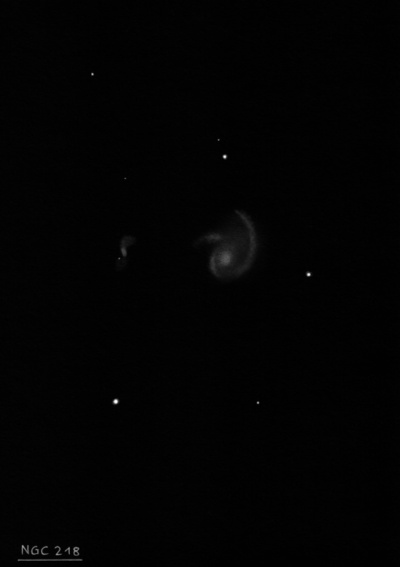
Édouard Stephan discovered NGC 218 = St VIIIa-3 on 17 Oct 1876 with the 31" reflector at the Marseille Observatory. His published position implies an offset of just 40" S of mag 8.9 SAO 54096 (given as the offset star) but there is nothing at this position and his description makes no mention of a nearby bright star. The only nearby candidate is UGC 440, which is located 45 tsec W and almost 2' N of Stephan's offsets, and this galaxy is taken as NGC 218 in all modern catalogues.
I checked Emmanuel Esmiol's 1916 re-reduction of Stephan's positions at Marseilles Observatory and found that NGC 218 was left off of the main tables, but replaced with an "Anonymous" galaxy using a different delta RA but the same offset star (SAO 54096) and the same delta Dec. Esmiol's new position corresponds exactly with UGC 480, although apparently this correction to the position of NGC 218 has gone unnoticed until now. At the bottom of the page is the note "wrongly identified as NGC 218". So, NGC 218 = UGC 480. Harold Corwin and Wolfgang Steinicke agree with this analysis. Wolfgang notes in his book on the history of the NGC, that Esmiol's catalogue gives 4 discoveries of Stephan that did not receive NGC designations, but he missed this connection with NGC 218. This identification has now been incorporated into NED, although it is still incorrect in HyperLeda (as of 2013) as well as the NGC/IC Project, which has not been updated in a long time.
400/500mm - 17.5" (9/1/02): fairly faint, fairly small, irregular shape and surface brightness, 1.0' diameter, broadly concentrated. Forms the right angle of a small isosceles triangle with two mag 13.5-14 stars 1.4' N and 1.3' W. Forms an interacting pair with MCG +06-02-017 1.4' E. The companion is very faint, small, elongated 2:1 N-S, 0.5'x0.25'. Member of the Pisces-Perseus Supercluster.
600/800mm - 24" (12/22/14): moderately bright and large, irregularly round, ~0.8' diameter though the halo increases in size and shape with averted vision. A brighter nucleus is offset to the east side of the galaxy, so could be mistaken for a knot in the halo. Forms an interacting pair with CGCG 519-022 1.4' ENE.
CGCG 519-022 is fairly faint, fairly small, slightly elongated N-S, 0.4'x0.2', very weak concentration. The SDSS reveals numerous thin, blue arm segments of NGC 218 that are apparently tidally stretched towards CGCG 519-022.
Notes by Steve Gottlieb
NGC 906
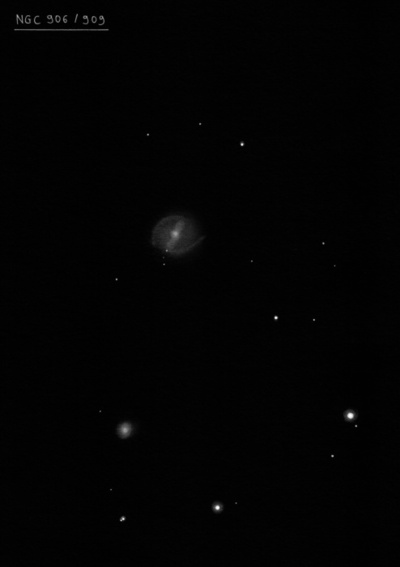
Édouard Stephan discovered NGC 906 = St X-5 on 30 Oct 1878 with the 31" reflector at the Marseille Observatory and recorded "eeF, irregular oval; dia = 45 arcsec". His position matches UGC 1868 = PGC 9188. Except for NGC 898 and NGC 923 (discovered by WH), Stephan discovered all the NGC galaxies in the cluster on the same night.
300/350mm - 13.1" (10/20/84): fairly faint, small, round. Located in the core of AGC 347 with NGC 909 3.5' S.
13.1" (11/13/82): faint, furthest north in the string of galaxies.
600/800mm - 24" (11/23/19): at 375x; fairly faint, round, relatively large, 50" diameter, diffuse halo, slightly brighter core/nucleus. Located in the core of AGC 347 with NGC 909 3.5' SSE and NGC 911 9' SSE.
Notes by Steve Gottlieb
NGC 51
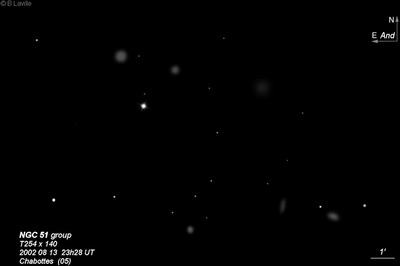
Lewis Swift discovered NGC 51 = Sw. II-8 on 7 Sep 1885, along with NGC 48 and 49, with the 16" refractor at the Warner Observatory. His RA was 0.5 minutes too large (similar offset as the other two). Bigourdan measured an accurate position on 13 Oct 1890 (repeated in the IC 2 Notes) and as well as Barnard (AN 4136).
400/500mm - 17.5" (8/31/86): fairly faint, fairly small, round, small bright core. A faint star is superimposed on SE edge (or a companion galaxy). Brightest and last of six in the group. Also the third of three NGC galaxies in the NGC 51 group.
Notes by Steve Gottlieb
UGC 1810
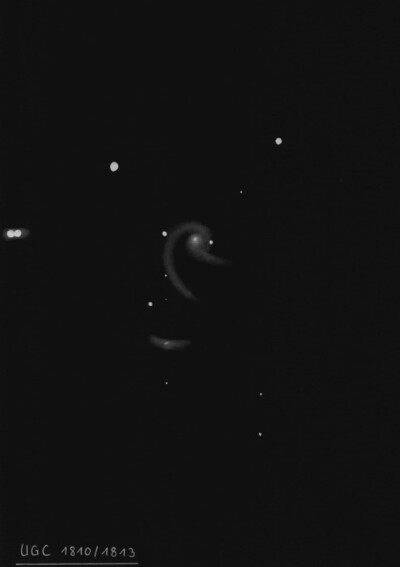
400/500mm - 17.5" (10/5/02): faint, small, elongated 4:3 SW-NE, 0.8'x0.6'. The main diffuse glow of the galaxy extends between a mag 13 just off the west side of the core and a mag 13.5 star at the east end of the halo. The surface brightness is fairly low except for a very small brighter core just following the mag 13 star. Located 1.8' SW of a mag 10 star and 3' W of ?251, a mag 8/9 2.5" pair that is a striking double at 263x. An edge-on companion UGC 1813 (forming Arp 273) close SE was not seen.
17.5" (8/6/02): very faint, fairly small, elongated 3:2 SW-NE, 0.9'x0.6'. Spans between two mag 13.5 stars on the NE end 40" from the core and superimposed on the west side just 19" from the core. The core of the galaxy is just a slightly brighter knot just following the preceding star. Two bright stars follow including mag 8.3 HD 14511 3.0' E and a mag 10 star 1.8' NE. At 263x, the mag 8 star was resolved into a very close unequal double = STF 251 = 8/9 at 2.5". Forms an interacting M51-type system (also classified as a collisional Ring galaxy) with UGC 1813 just 1.3' SE but the fainter companion was only marginally visible (viewed fairly low in the east). This pair is Arp 273 and is a Perseus-Pisces Supercluster member.
900/1200mm - 48" (10/29/16): at 488x; the unusual spiral structure in UGC 1810 = Hubble's "Rose" was easily visible. A long thin tidal arm can be traced attached to the north side of the bright core. It unfurls sharply counterclockwise to the east and passes through a mag 14 star. The arm shoots due south of this star on the east end of the galaxy and continues to curl southwest. It terminates due south (or a bit west) of the core, ~1' from center. A second low surface brightness arm is attached on the south side of the core and swings to the west, south of a superimposed mag 13.5 star. STF 251, an excellent 9.0/9.6 pair at 2.1" is 2.9' E. Forms a striking interacting pair (Arp 273 = VV 323) with UGC 1813 1.3' SE.
48" (2/18/12): larger and brighter component of Arp 273 along with UGC 1813, a thin edge-on 1.3' SE. At 488x the galaxy has an interesting chaotic appearance. It contains a very small bright core, ~15" diameter, with a bright nucleus. A mag 13.5 star is superimposed at the west edge of the core. A spiral arm emerges at the north side of the core and bends counterclockwise east towards a mag 14 star 40" NE of center and then fades out. The arm then reappears heading due south of the star for ~30", so the two sections seem detached at the star and unrelated. To the southwest of the core is a low surface brightness halo, increasing the overall size to 1.5'x1.0'.
Notes by Steve Gottlieb
NGC 27
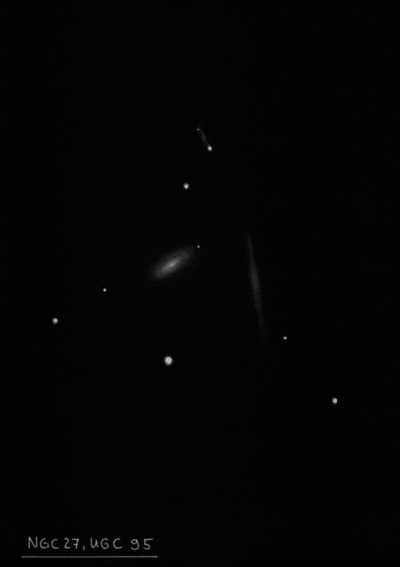
Lewis Swift discovered NGC 27 = Sw. I-1 on 3 Aug 1884 with a 16" refractor at Warner Observatory and recorded as "vvF; vS; E; B* nr." His position matches UGC 96 = PGC 742.
400/500mm - 17.5" (10/8/94): fairly faint, fairly small, elongated 5:2 WNW-ESE, 1.0'x0.4', broad concentration to a brighter core. Located 1.5' N of mag 9.5 SAO 73786. A wide pair of mag 13.5 stars are 1.4' NNW and 2.0' NNW. Forms a pair with UGC 105 10' SE. Alpheratz (Alpha Andromedae, V = 2.1) lies 28' WNW.
17.5" (10/17/87): faint, small, roundish, very small brighter core. Situated between two mag 13 and 14 stars.
600/800mm - 24" (8/25/19): at 324x; moderately bright and large, oval 2:1 WNW-ESE, ~0.9'x0.4'. Contains a round, small bright core that gradually increased to a slightly brighter stellar nucleus. A mag 10.5 star is 1.6' S.
NGC 27 forms a close pair with superthin galaxy UGC 95 just 1.5' SW. At 225x and 324x it appeared as a moderately large, thin ghostly sliver, ~10:1 N-S, 1.0'x0.1'. The surface brightness was very low and nearly even with only a slightly brighter core. I could often hold it continuously at 225x once acquired.
CGCG 499-70, situated 10' NE, appeared faint, fairly small, very elongated 4:1 WSW-ENE, ~35"x8", low even surface brightness.
Notes by Steve Gottlieb
NGC 70
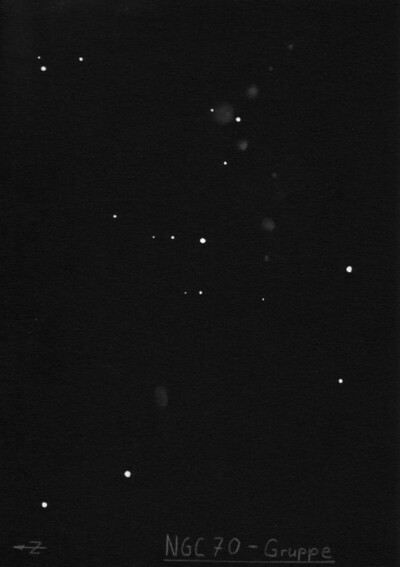
400/500mm - 17.5" (8/27/87): very faint, very small, round, small bright core. Located in the core of NGC 68 group and nearly between two mag 13.5 stars 25" NE and 20" SSW. In an interconnected trio with NGC 68 1.0' SW and NGC 71 1.0' SSE.
600/800mm - 24" (9/15/12): fairly faint to moderately bright, fairly small, slightly elongated ~N-S. Extends between two mag 14 stars separated by 42". Sharply concentrated with a small, high surface brightness core and a much fainter halo.
Notes by Steve Gottlieb
NGC 11
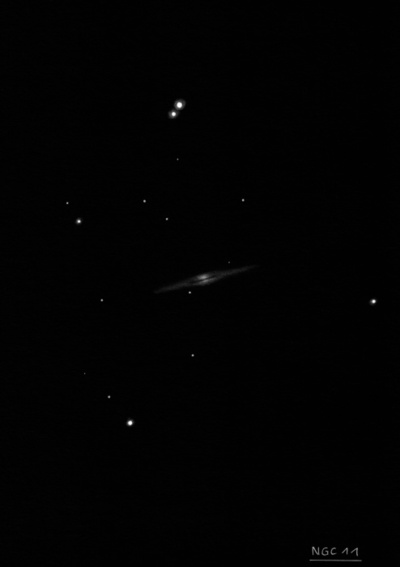
Édouard Stephan discovered NGC 11 = St XII-2 on 24 Oct 1881 with the 31" silvered-glass reflector at the Marseille Observatory and described "vF; vS; little irregular oval SE to NW; two very faint stars involved." Although Stephan did not record this object as an edge-on (very elongated), his position clearly matches UGC 73 = PGC 642.
400/500mm - 17.5" (10/17/87): faint, fairly small, edge-on WNW-ESE. A close double star with mag 11/12 components lies 3' N.
Notes by Steve Gottlieb
NGC 90
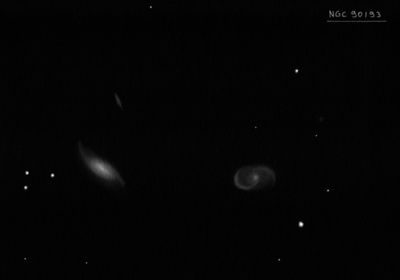
R.J. Mitchell discovered NGC 90 using Lord Rosse's 72" on 26 Oct 1854. The description mentioned "Several S; F neb visible at once in finder" so JH assumed at least 3 objects were discovered, which he catalogued as GC 40, 41, 42. But a sketch of the NGC 90 field shows only two nebulae labeled as Alpha (now NGC 90) and Beta (now NGC 93). Herman Schultz observed the field on 17 Oct 1866 with the 9.6" refractor at Uppsala and measured an object he thought was GC 40, but was actually Mitchell's Alpha. His micrometric position matches UGC 208 = PGC 1405. Because of an uncertainty in the position and identification, Dreyer catalogued this object as GCS 5096 with the comment "Query = GC 40, 41, 42?". Dreyer equated GC 40 = 5096 in the NGC.
Modern catalogues misidentify UGC 208 as NGC 91 but Schultz's position for NGC 91 falls precisely on a very faint star 1.9' S. This misidentification may have originated in Curtis' description of nebulae (1918) based on Crossley photographs at Lick observatory. See Corwin's notes for further discussion.
300/350mm - 13.1" (9/29/84): very faint, elongated NW-SE. A mag 13 star is 1' SW.
400/500mm - 17.5" (9/19/87): very faint, small (only the central portion of the galaxy observed), slightly elongated, weak concentration. A mag 12 star is 1.3' SW. Forms a pair with NGC 93 2.8' E. Located on the east side of the NGC 80 group 7.0' ESE of NGC 83.
900/1200mm - 48" (10/30/16): at 488x and 610x; bright, oval 3:2 E-W, sharply concentrated with a very bright roundish core (slightly elongated at 610x) and a fairly large oval halo, ~60"x40". A spiral arm is visible on the northwest side, curling clockwise to the south but the long, thin tidally stretched extensions to the northwest and southeast were not seen. Forms a striking (interacting) pair with NGC 93 2.8' ENE. A mag 12 star is 1.3' SW. Although this galaxy is often identified as NGC 91, that number applies to a mag 14.8 star 1.9' S.
NGC 90 = Arp 65 was classified as a Spiral galaxy with small, high surface-brightness companions on arms. LEDA 1669552, the "companion" just beyond the northwest tidal extension (2.4' NW of NGC 90), appeared faint (V ~17.1), small, elongated 3:2 N-S, 10"x6". A mag 15.7 star is 30" SE. No redshift is available on this object, so it may lie far in the background.
Notes by Steve Gottlieb
UGC 1840
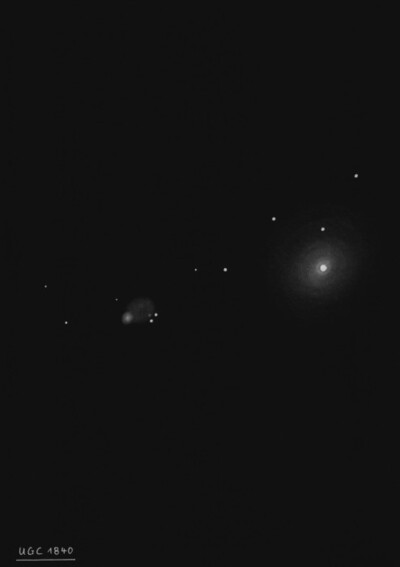
The third component was a very faint, extremely small "knot", perhaps 4" diameter (barely nonstellar), that was superimposed south of center. It formed the north vertex of a small equilateral triangle (sides 15"-20") with the pair of stars. This "knot" is classified as the ring nucleus (Arp 145:RN) in Madore's 2009 "Atlas of Collisional Ring Galaxies". Arp 145 is located just 3.7' SE of mag 5.8 HD 14622 and the star was kept out of the field to avoid glare. The ring and collider are given two PGC numbers, 9060 and 9062, although there is disagreement in NED and LEDA on which objects they apply to.
Arp 145 is located 42' SW of the center of AGC 347 and it has a matching redshift, so is an outlying member of the cluster.
900/1200mm - 48" (10/25/11): at 488x and 610x, this interesting ring galaxy (Arp 145) was composed of three components. The brightest is the "collider" component (Anon 0220+41A) at the southeast edge of the "ring". It appeared moderately bright, small, round, 20" diameter, high surface brightness, containing a very small bright nucleus. The "ring" component generally appeared as a fairly large, roundish glow, at least 1.0' diameter, with an irregular surface brightness but no central brightening. A 20" pair of mag 12/13 stars are superimposed on the south and southwest end of the glow and detract a bit from viewing. Occasionally, though, the "ring" popped and a brighter rim and darker center appeared, mimicking a fairly large, weakly annular planetary nebula!
Notes by Steve Gottlieb
HCG 10
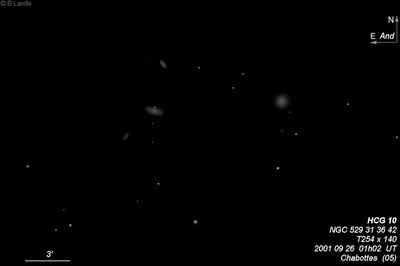
| Type | GALCL [S3] |
| RA | 01:26:07.4 |
| Dec | +34:41:27.0 |
| major_axis | 14.2' |
| mag | 10.1 |
| surface_bright | 99.9 |
HCG 8
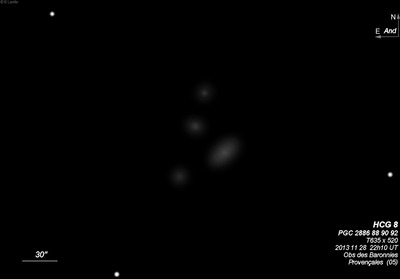
| Type | GALCL [E2] |
| RA | 00:49:36.8 |
| Dec | +23:34:51.0 |
| major_axis | 96.0'' |
| mag | 12.3 |
| surface_bright | 99.9 |
NGC 523
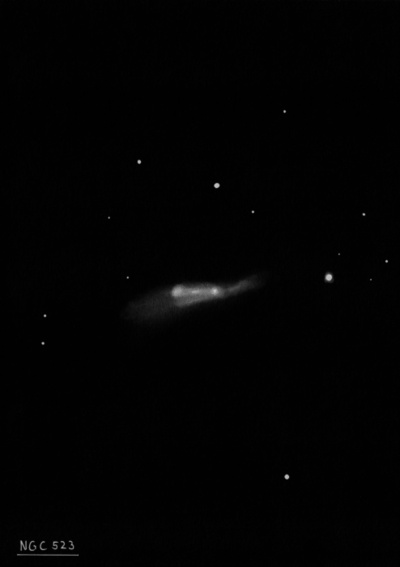
| Type | GX [Sbc/P] |
| RA | 01:25:20.7 |
| Dec | +34:01:31.0 |
| major_axis | 2.5' |
| minor_axis | 42.0'' |
| position_angle | 108.0 |
| mag | 12.7 |
| surface_bright | 13.0 |
HCG 1
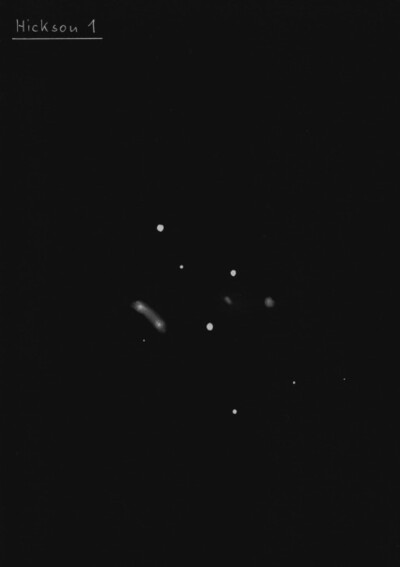
| Type | GALCL [S3] |
| RA | 00:26:00.2 |
| Dec | +25:43:05.0 |
| major_axis | 3.8' |
| mag | 12.8 |
| surface_bright | 99.9 |
Abell 262
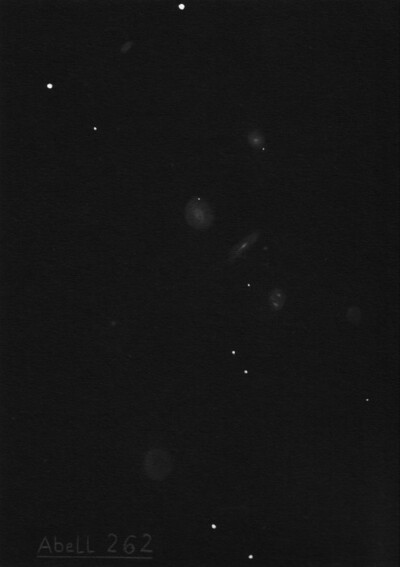
| Type | GALCL [01III] |
| RA | 01:52:42.0 |
| Dec | +36:09:00.0 |
| major_axis | 100.8' |
| mag | 13.0 |
Abell 347
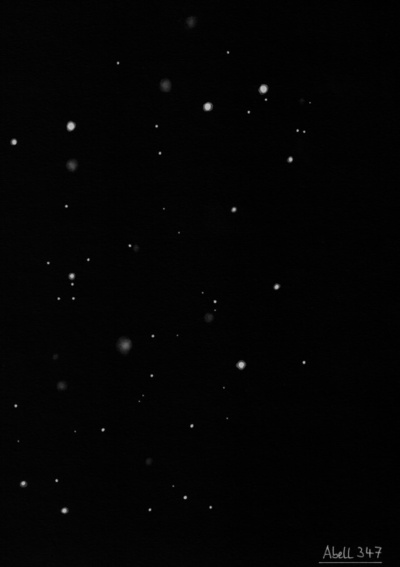
| Type | GALCL [01II-III] |
| RA | 02:25:06.0 |
| Dec | +41:52:00.0 |
| major_axis | 56.0' |
| mag | 13.0 |
Vy 2-3
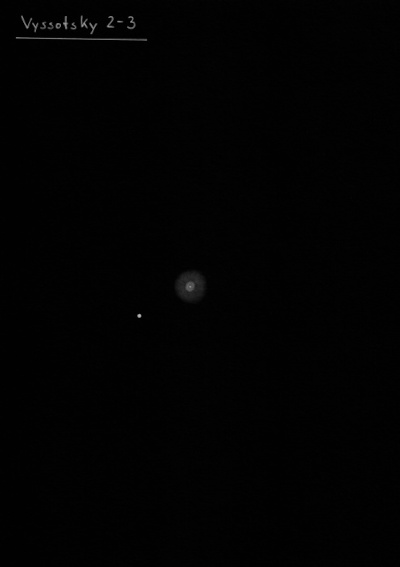
| Type | PN |
| RA | 23:22:57.9 |
| Dec | +46:53:58.0 |
| minor_axis | 48.0'' |
| mag | 13.9 |
| surface_bright | 8.0 |
K 1-20
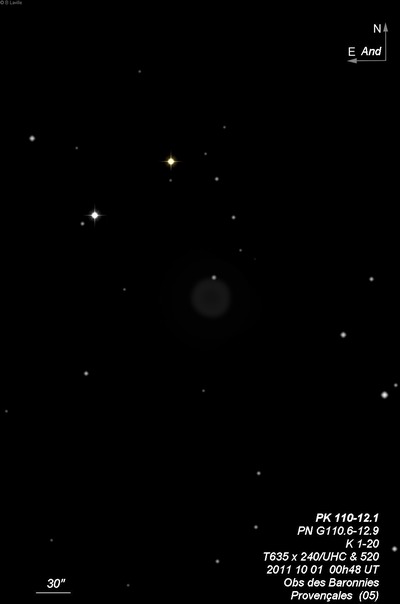
| Type | PN |
| RA | 23:39:10.8 |
| Dec | +48:12:29.0 |
| major_axis | 36.0'' |
| minor_axis | 30.0'' |
| mag | 16.5 |
| surface_bright | 15.0 |